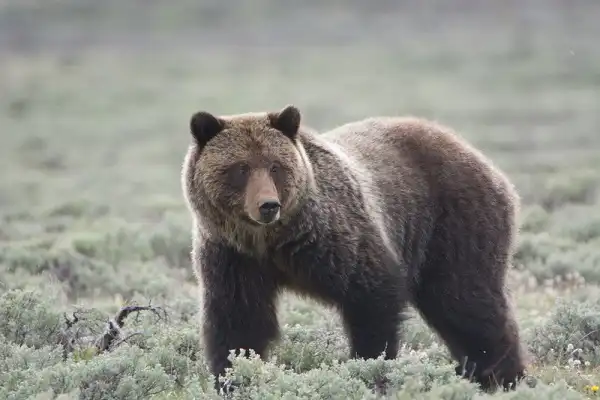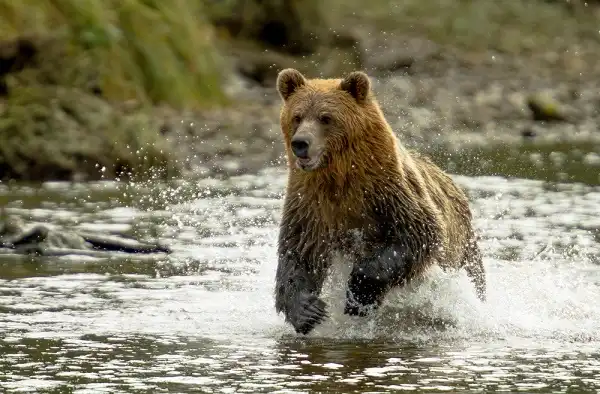Grizzly bears are one of the most feared animals in North America. They can be found in the mountainous regions of Canada and the United States, and often venture into areas where humans live. While they generally avoid human contact, their size and strength make them a potentially lethal threat. In this blog post, we’ll explore some interesting facts about grizzly bears and dispel some myths about these magnificent creatures.

Grizzly Bear Description
Grizzly bears are large mammals. The most distinctive feature of grizzlies is the large hump on their back, which is used as a counterbalance when running or climbing. Grizzly fur is usually brownish-black in color, but some individuals may have blond or even white fur (which is known as the “blond phase”). Grizzlies have long, curved claws that they use for digging and tearing into food such as roots and nuts. They also have small ears that help them keep their balance while running and climbing, and a powerful jaw full of sharp teeth. Grizzlies have excellent eyesight. Furthermore, grizzlies often mark their territory by standing on top of rocks or logs to leave scent marks. This marking behavior helps them protect their territories from encroaching individuals from other groups, thus ensuring that resources remain accessible within their own group’s area of influence.
Grizzly Bear Habitat
Grizzly bears are typically found in the mountainous regions of North America, ranging from Alaska to as far south as Mexico. Their territories may extend up to hundreds of miles and can span multiple different ecosystems, such as forests, tundras, and meadows. Grizzlies prefer areas where there is plenty of food sources and cover for denning, such as dense forests with a variety of vegetation types and open fields surrounded by trees. They are also common in alpine environments above 11,000 feet, where they hunt for small mammals like marmots and ground squirrels. Grizzlies are adapted to withstand cold temperatures due to their thick fur coats which keep them warm during hibernation periods during winter months. Even so, climate change has caused some areas previously suitable for grizzly bear habitat to become less hospitable due to shrinking food supply or increasing temperatures making it more difficult for them to survive harsh climates. This is why many conservation groups are calling upon governments around the world to take decisive action in protecting this majestic species before it is too late!
Grizzly Bear Diet
Grizzly bears are omnivores, meaning they feed on a variety of different foods. Their primary diet consists of fish, small mammals, carrion, and roots. They will also eat insects such as ants and bees, berries, nuts, and other plant material. In areas where there is a lot of human activity, grizzlies have been known to scavenge food from garbage cans or dumpsters. In the summer months when salmon is abundant in the rivers and streams grizzlies are most active in search of this food source. They are powerful swimmers and will spend hours fishing for these fish with their claws. Additionally, they can climb trees to get at honeybees’ nests or hunt for small game such as marmots and ground squirrels in alpine habitats. In the winter months when food is scarce grizzlies will enter a state of deep hibernation. During this time they will not eat anything but instead, rely on stored fat reserves to sustain them until spring arrives. Grizzly bears must consume a diet rich in calories due to their large size and high metabolisms; thus they must consume large amounts of food each day to meet their energy needs. That said, the amount eaten by an individual bear depends largely on its age; younger bears tend to be hungrier than older ones since they require more energy for growth purposes.

Grizzly Bear Size
Grizzly bears are a large species of bear that can be found throughout North America and Eurasia. Adult males typically weigh between 500 and 800 pounds, while adult females usually weigh 300 to 500 pounds. Males are typically around 7 feet tall when standing on their hind legs, while females measure 5 to 6 feet in height. In terms of length, grizzlies range from 4 to 8 feet long with males obviously being larger than females. They have long front claws that can measure up to 4 inches in length which they use for digging into the ground or tree trunks in search of food.
Grizzly Bear Lifespan
Grizzly bears have a relatively long lifespan in the wild, averaging between 25 and 30 years. However, some grizzlies have been known to live longer with one individual reaching an incredible 50 years old in the wild! In captivity, grizzlies can live for even longer with some individuals reaching up to 35 years of age. Grizzly bear cubs are typically born in January or February and remain with their mothers until they are around 2-3 years old when they become independent. During this time they learn important skills such as hunting and gathering food as well as navigating their environment. Typically, juvenile grizzlies reach sexual maturity at 3 to 4 years of age. The longevity of grizzly bears is largely determined by the amount of food available during seasonal fluctuations. During times of plentiful food sources, it is believed that grizzlies can live longer due to more energy reserves being stored away for leaner times. Additionally, grizzlies living in areas where there is less competition from other large predators tend to live longer due to a decreased risk of injury or attack when scavenging for food sources.
Grizzly Bear Behavior
Grizzly bears have unique and varied behavior. They are generally considered to be solitary animals, but during certain times of the year, they may gather in large groups. In late summer, grizzlies often congregate at salmon streams to feed on the abundant fish before making their way into hibernation for the winter. During this time, individual bears tend to keep their distance from one another, although some interact and form temporary social bonds. Grizzlies are also known for their intelligence and resourcefulness; they use various tools such as rocks or sticks to dig for roots and tubers as well as using sticks to pull down tree branches that contain fruit or nuts. They can also remember where resources are located so they can return at a later date if needed. When it comes to defense, grizzlies are well-equipped with powerful claws and teeth that allow them to defend themselves against predators such as wolves or mountain lions. Females also become extremely protective of their cubs when it is perceived there is a threat present; they will typically stand their ground by roaring, swatting and even charging an enemy in order to protect their young. In addition, grizzly bears communicate with one another via scent marking and vocalizations such as snorting sounds that can be heard up to half a mile away! This helps them share important information about food sources, territorial boundaries, and mating opportunities with other members of their group.

Grizzly Bear Speed
Grizzly bears are not typically considered to be the fastest animals in the wild, but they can reach impressive speeds when needed. While running, grizzlies can reach speeds of up to 40 mph (64 km/h) for short distances such as when escaping from danger or chasing after prey. On average, grizzlies tend to travel at a much slower pace of 3-5 mph (4-8 km/h) while searching for food or exploring their surroundings. Though not known for their agility and speed, grizzly bears have been observed ambling along at a steady pace for several miles at a time! This is due to their unique gait and strong muscles that allow them to keep going without tiring quickly, even over long distances. Additionally, they use this slower pace in order to conserve energy during lean times when food sources are scarce. When it comes to swimming, grizzlies have also been found to be quite adept; these powerful beasts can swim for hours on end using powerful front legs and hindquarters that propel them through the water with great agility and speed. They have been recorded swimming across lakes in Alaska up to 10 miles (16 km) long! Grizzly bears’ climbing skills are nothing short of incredible as well; they have even been known to scale sheer cliffs and walls of more than 100 feet (30 m) in height with remarkable speed and efficiency! This agility gives them an advantage when hunting for food or reaching dens located within rocky outcroppings and high terrain.
Grizzly Bear Hunting
Grizzly Bear Hunting is an activity that has been practiced by humans for centuries and offers many advantages to those who take part in it. In the wild, grizzlies are powerful animals that have adapted to survive in a variety of habitats including forests, tundras, and mountains. As such, they can be found all across North America and even parts of Europe and Asia. Hunting these majestic creatures requires skill and preparation as they can be dangerous when provoked. It is essential to ensure that you are adequately familiar with the area where you will be hunting as well as being aware of any potential risks posed by the environment itself. Additionally, hunters must also take great care to only shoot when absolutely necessary for safety reasons. In terms of equipment, hunters typically use high-powered rifles that are capable of taking down larger games such as grizzly bears. Typical ammunition used for this purpose includes .30-06 Springfield or .300 Winchester Magnum cartridges which offer sufficient penetration power for clean kills when hunting large game animals like bears. When it comes to tactics, experienced grizzly bear hunters often employ ambush techniques whereby the hunter hides in a location where they anticipate an animal may cross before making their shot; however, stalking can also be used depending on the circumstances of each hunt. Patience is key when hunting these animals as they have extremely good hearing and smell which means they might catch wind of your presence before you even have time to line up your shot!

Conclusion
Grizzly bears are powerful and agile creatures that have adapted to a variety of habitats across North America, Europe, and Asia. Their ability to swim, run, and climb make them formidable hunters capable of adapting to any environment they inhabit. They also require a skilled hunter with the right equipment if they are to be hunted safely. With proper knowledge and respect for this amazing species, grizzly bear hunting can be an incredibly rewarding experience!
Frequently Asked Question


